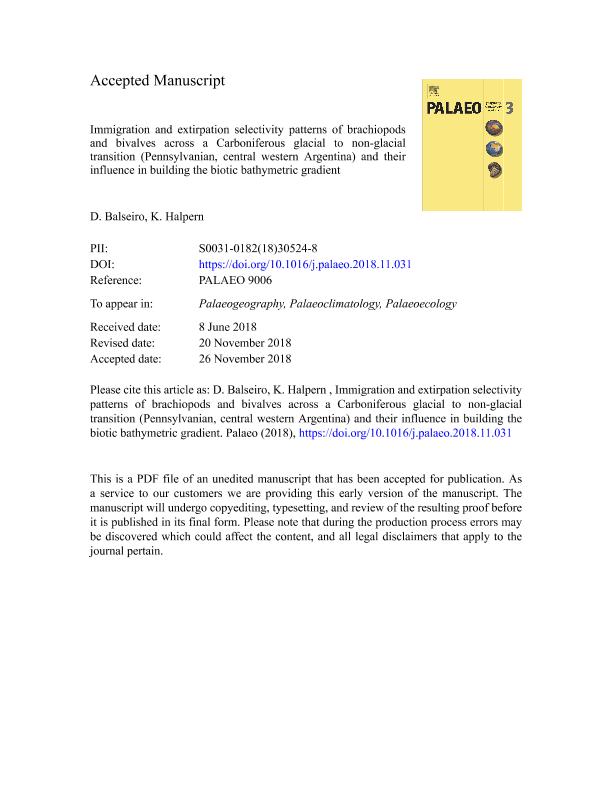Mostrar el registro sencillo del ítem
dc.contributor.author
Balseiro, Diego

dc.contributor.author
Halpern, Karen

dc.date.available
2019-09-13T15:12:51Z
dc.date.issued
2018-11
dc.identifier.citation
Balseiro, Diego; Halpern, Karen; Immigration and extirpation selectivity patterns of brachiopods and bivalves across a Carboniferous glacial to non-glacial transition (Pennsylvanian, central western Argentina) and their influence in building the biotic bathymetric gradient; Elsevier Science; Palaeogeography, Palaeoclimatology, Palaeoecology; 516; 11-2018; 11-21
dc.identifier.issn
0031-0182
dc.identifier.uri
http://hdl.handle.net/11336/83526
dc.description.abstract
The growth and demise of glaciers during the Late Paleozoic ice age had profound consequences on the marine biota. In central western Argentina the transition from glacial to non-glacial interval during the Pennsylvanian, caused a major regional turnover which remodeled the bathymetric diversity gradient. In order to understand the nature of the environmental changes related to such turnover event, we compared selectivity patterns in extirpation and immigration of bivalves and brachiopods using logistic regression. We tested for a wide range of potential drivers of extirpation and immigration, namely body size, geographic range size, environmental breadth, preferred depth, metabolic rates, infaunalism and taxonomic identity. While extirpation preferentially hit brachiopods and genera having smaller geographic ranges and smaller body sizes, immigration was related to genera with preference for deeper environment and small geographic ranges.Extirpation selectivity was not uniform along the bathymetric gradient. Both geographic range and body size selectivity are stronger towards deeper environments. Each clade, on the other hand, showed idiosyncratic responses to climate change. While brachiopods show extirpation selectivity for smaller geographic ranges, small sized bivalves were preferentially extirpated. These contrasting selectivity regimes, however, could be reflecting different faunal responses to the same environmental changing factor, namely higher thermal amplitude. Immigration in both brachiopods and bivalves was related to preference to deep environments, confirming previous results. However, brachiopods also showed preferential immigration of small geographic range genera, which is puzzling given the extinction selectivity related to the glacial non-glacial transition. Possible explanations point to a brief time span in which an increase in thermal amplitude occurred. The rapid climate changes, particularly related to a rise in maximum temperatures, lead the ecological response of the benthic faunas. Differences in extinction and immigration selectivity along the bathymetric gradient, suggest that the turnover event also remodeled the bathymetric gradient in body size and biogeographic structure and brachiopod:bivalve proportions. Such changes were driven by extirpation, contrasting with the remodeling of the bathymetric diversity gradient that was driven by immigration. Our results, therefore, highlight that immigration and extirpation can shape different aspects of the bathymetric biotic gradient.
dc.format
application/pdf
dc.language.iso
eng
dc.publisher
Elsevier Science

dc.rights
info:eu-repo/semantics/openAccess
dc.rights.uri
https://creativecommons.org/licenses/by-nc-sa/2.5/ar/
dc.subject
Logistic Regression
dc.subject
Lpia
dc.subject
Bathymetric Gradient
dc.subject
Geographic Range
dc.subject
Body Size
dc.subject
Turnover
dc.subject.classification
Paleontología

dc.subject.classification
Ciencias de la Tierra y relacionadas con el Medio Ambiente

dc.subject.classification
CIENCIAS NATURALES Y EXACTAS

dc.title
Immigration and extirpation selectivity patterns of brachiopods and bivalves across a Carboniferous glacial to non-glacial transition (Pennsylvanian, central western Argentina) and their influence in building the biotic bathymetric gradient
dc.type
info:eu-repo/semantics/article
dc.type
info:ar-repo/semantics/artículo
dc.type
info:eu-repo/semantics/publishedVersion
dc.date.updated
2019-09-04T21:04:14Z
dc.journal.volume
516
dc.journal.pagination
11-21
dc.journal.pais
Países Bajos

dc.journal.ciudad
Amsterdam
dc.description.fil
Fil: Balseiro, Diego. Consejo Nacional de Investigaciones Científicas y Técnicas. Centro Científico Tecnológico Conicet - Córdoba. Centro de Investigaciones en Ciencias de la Tierra. Universidad Nacional de Córdoba. Facultad de Ciencias Exactas Físicas y Naturales. Centro de Investigaciones en Ciencias de la Tierra; Argentina
dc.description.fil
Fil: Halpern, Karen. Universidad Nacional de Mar del Plata. Facultad de Ciencias Exactas y Naturales. Instituto de Geología de Costas y del Cuaternario. Provincia de Buenos Aires. Gobernación. Comisión de Investigaciones Científicas. Instituto de Geología de Costas y del Cuaternario; Argentina. Consejo Nacional de Investigaciones Científicas y Técnicas. Centro Científico Tecnológico Conicet - Mar del Plata; Argentina
dc.journal.title
Palaeogeography, Palaeoclimatology, Palaeoecology

dc.relation.alternativeid
info:eu-repo/semantics/altIdentifier/url/https://linkinghub.elsevier.com/retrieve/pii/S0031018218305248
dc.relation.alternativeid
info:eu-repo/semantics/altIdentifier/doi/http://dx.doi.org/10.1016/j.palaeo.2018.11.031
Archivos asociados
